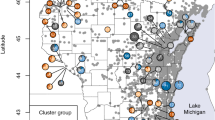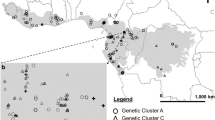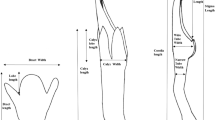Abstract
Phragmites australis (common reed) is a widespread perennial grass of wetland habitats, with cryptic native and introduced subspecies in North America. We determined the relative abundance of the subspecies and the distributions of plastid DNA haplotypes throughout British Columbia, Canada, at the northwestern distribution limit of common reed in North America. Of 203 specimens assigned to subspecies using molecular markers, we identified only 9 plants as the introduced ssp. australis; all remaining samples were the native ssp. americanus. The two subspecies co-occurred at only one locality. We identified four native haplotypes (one widespread in British Columbia and three others more localized) and two introduced haplotypes. Using plants of known haplotype, we assessed the utility of different morphological traits and trait combinations for distinguishing native and introduced subspecies in this geographic region. No single morphological trait was diagnostic, but principal components analysis and identification indices based on combinations of traits consistently separated the native and introduced subspecies in our sample. Two- or three-trait combinations of ligule length, lemma length and stem anthocyanic coloration gave the best separation. These indices could reduce the need for confirmation of the introduced subspecies using molecular tools, facilitating efforts to monitor and control this invasive plant.





Similar content being viewed by others
References
Brisson J, Paradis E, Bellavance M-E (2008) Evidence of sexual reproduction in the invasive common reed (Phragmites australis subsp. australis; Poaceae) in eastern Canada: a possible consequence of global warming? Rhodora 110:225–230
Catling PM (2007) Additional notes on the identification of alien Phragmites in Canada. Botanical Electronic News No 370. http://www.ou.edu/cas/botany-micro/ben/ben366.html
Catling PM, Mitrow G (2011) The recent spread and potential distribution of Phragmites australis subsp. australis in Canada. Canadian Field-Naturalist 125(2):95–104
Catling PM, Mitrow G, Black L (2007) Analysis of stem color and correlated morphological characters for grouping Phragmites (Poaceae) taxa in eastern Ontario. Rhodora 109:125–136
Clement M, Posada D, Crandall K (2000) TCS: a computer program to estimate gene genealogies. Molecular Ecology 9:1657–1660
Cronin JT, Bhattarai GP, Allen WJ, Meyerson LA (2015) Biogeography of a plant invasion: plant-herbivore interactions. Ecology 96:1115–1127
Douhovnikoff V, Hazelton ELG (2014) Clonal growth:invasion or stability? A comparative study of clonal architecture and diversity in native and introduced lineages of Phragmites australis (Poaceae). American Journal of Botany 101:1577–1584
Doyle JJ, Doyle JL (1987) A rapid DNA isolation procedure for small quantities of fresh leaf tissue. Phytochemical Bulletin 9:11–15
Guo W-Y, Lambertini C, Li X-Z, Meyerson LA, Brix H (2013) Invasion of old world Phragmites australis in the new world: precipitation and temperature patterns combined with human influences redesign the invasive niche. Global Change Biology 19:3406–3422
Hauber DP, Saltonstall K, White DA, Hood CS (2011) Genetic variation in the common reed, Phragmites australis, in the Mississippi River Delta marshes: evidence for multiple introductions. Estuaries and Coasts 34:851–862
Kettenring KM, de Blois S, Hauber DP (2012) Moving from a regional to a continental perspective of Phragmites australis invasion in North America. AoB PLANTS 2012: pls040. doi:10.1093/aobpla/pls040
Kettenring KM, Whigham DF, Hazelton ELG, Gallagher SK, Weiner HM (2015) Biotic resistance, disturbance, and mode of colonization impact the invasion of a widespread, introduced wetland grass. Ecological Applications 25:466–480
Kirk H, Paul J, Straka J, Freeland JR (2011) Long-distance dispersal and high genetic diversity are implicated in the invasive spread of the common reed, Phragmites australis (Poaceae), in northeastern North America. American Journal of Botany 98:1180–1190
Kulmatiski A, Beard KH, Meyerson LA, Gibson JR, Mock KE (2010) Nonnative Phragmites australis invasion into Utah wetlands. Western North American Naturalist 70:541–552
Lambert AM, Saltonstall K, Long R, Dudley TL (2016) Biogeography of Phragmites australis lineages in the southwestern United States. Biological Invasions 18:2597–2617
Lambertini C, Gustafsson MHG, Frydenberg J, Lissner J, Speranza M, Brix H (2006) A phylogeographic study of the cosmopolitan genus Phragmites (Poaceae) based on AFLPs. Plant Systematics and Evolution 258:161–182
Lambertini C, Mendelssohn IA, Gustafsson MHG, Oleson B, Riis T, Sorrell BK, Brix H (2012a) Tracing the origin of Gulf Coast Phragmites (Poaceae): a story of long-distance dispersal and hybridization. American Journal of Botany 99:538–551
Lambertini C, Sorrell BK, Riis T, Olesen B, Brix H (2012b) Exploring the borders of European Phragmites within a cosmopolitan genus. AoB plants 2012: pls020. doi:10.1093/aobpla/pls020
McCormick MK, Kettenring KM, Baron HM, Whigham DF (2010) Extent and reproductive mechanisms of Phragmites australis spread in brackish wetlands in Chesapeake Bay, Maryland (USA). Wetlands 30:67–74
Meyerson LA, Cronin JT (2013) Evidence for multiple introductions of Phragmites australis to North America: detection of a new non-native haplotype. Biological Invasions 15:2605–2608
Meyerson LA, Saltonstall K, Chambers RM (2009) Phragmites australis In eastern North America: a historical and ecological perspective. In: Silliman BR, Grosholz E, Bertness MD (eds) Human impacts on salt marshes: a global perspective. University of California Press, Berkeley and Los Angeles, pp 57–81
Meyerson LA, Viola DV, Brown RN (2010) Hybridization of invasive Phragmites australis with a native subspecies in North America. Biological Invasions 12:103–111
Orson RA (1999) A paleoecological assessment of Phragmites australis in New England tidal marshes: changes in plant community structure during the last few millennia. Biological Invasions 1:149–158
Paul J, Vachon N, Garroway CJ, Freeland JR (2010) Molecular data provide strong evidence of natural hybridization between native and introduced lineages of Phragmites australis in North America. Biological Invasions 12:2967–2973
Plut K, Paul J, Ciotir C, Major M, Freeland JR (2011) Origin of non-native Phragmites australis in North America, a common wetland invader. Fundamentals of Applied Limnology 179:121–129
Pyšek P, Hulme PE, Meyerson LA, Smith GF, Boatwright JS, Crouch NR, Figueiredo E, Foxcroft LC, Jarošík V, Richardson DM, Suda J, Wilson JRU (2013) Hitting the right target: taxonomic challenges for, and of, plant invasions. AoB PLANTS 5: plt042. doi:10.1093/aobpla/plt042
Saltonstall K (2002) Cryptic invasions by a non-native genotype of the common reed, Phragmites australis, into North America. Proceedings of the National Academy of Sciences (USA) 99:2445–2449
Saltonstall K (2003a) Genetic variation among north American populations of Phragmites australis: implications for management. Estuaries 26:444–451
Saltonstall K (2003b) Microsatellite variation within and among north American lineages of Phragmites australis. Molecular Ecology 12:1689–1702
Saltonstall K (2003c) A rapid method for identifying the origin of north American Phragmites populations using RFLP analysis. Wetlands 23:1043–1047
Saltonstall K (2011) Remnant native Phragmites australis maintains genetic diversity despite multiple threats. Conservation Genetics 12:1027–1033
Saltonstall K (2016) The naming of Phragmites haplotypes. Biological Invasions 18:2433–2441
Saltonstall K, Hauber D (2007) Notes on Phragmites australis (Poaceae: Arundinoideae) in North America. Journal of the Botanical Research Institute of Texas 1(1):385–388
Saltonstall K, Peterson P, Soreng R (2004) Recognition of Phragmites australis subsp. americanus (Poaceae: Arundinoideae) in North America: evidence from morphological and genetic analysis. SIDA, Contributions to Botany 21(2):683–692
Saltonstall K, Castillo HE, Blossey B (2014) Confirmed field hybridization of native and introduced Phragmites australis (Poaceae) in North America. American Journal of Botany 101:211–215
Saltonstall K, Lambert AM, Rice N (2016) What happens in Vegas, better stay in Vegas: Phragmites australis hybrids in the Las Vegas wash. Biological Invasions 18:2463–2474
Swearingen J, Saltonstall K (2010) Phragmites field guide: distinguishing native and exotic forms of common reed (Phragmites australis) in the United States. Plant Conservation Alliance, Weeds Gone Wild http://www.nps.gov/plants/alien/pubs/index.htm
Taberlet P, Gielly L, Pautou G, Bouvet J (1991) Universal primers for amplification of three non-coding regions of chloroplast DNA. Plant Molecular Biology 17:1105–1109
Thompson JD, Gibson TJ, Plewniak F, Jeanmougin F, Higgins DG (1997) The ClustalX windows interface: flexible strategies for multiple sequence alignment aided by quality analysis tools. Nucleic Acids Research 24:4876–4882
Vasquez EA, Glenn EP, Brown JJ, Guntenspergen GL, Nelson SG (2005) Salt tolerance underlies the cryptic invasion of north American salt marshes by an introduced haplotype of the common reed Phragmites australis (Poaceae). Marine Ecology Progress Series 298:1–8
Vasquez EA, Glenn EP, Guntenspergen GL, Brown JJ, Nelson SG (2006) Salt tolerance and osmotic adjustment of Spartina alterniflora (Poaceae) and the invasive M haplotype of Phragmites australis (Poaceae) along a salinity gradient. American Journal of Botany 93:1784–1790
Waterhouse AM, Procter JB, Martin DMA, Clamp M, Barton GJ (2009) Jalview version 2- a multiple sequence alignment editor and analysis workbench. Bioinformatics 25:1189–1191
Wu CA, Murray LA, Hefferman KE (2015) Evidence for natural hybridization between native and introduced lineages of Phragmites australis in the Chesapeake Bay watershed. American Journal of Botany 102:805–812
Acknowledgements
This project was carried out under a contract funded by the Ministry of Forests, Lands and Natural Resource Operations, Government of British Columbia. We acknowledge the help of all those who collected specimens for this study, including S. Cesselli, M. DeWolf, R. Haegedorn, C. MacRae, K. May, D. McLean, J. E. Portelance, R. Rudland, B. Smith and E. Sonntag. We also thank the Royal British Columbia Museum (V) for permission to analyze leaf tissue from herbarium specimens of P. australis.
Author information
Authors and Affiliations
Corresponding author
Rights and permissions
About this article
Cite this article
Allen, G.A., McCormick, L.J., Jantzen, J.R. et al. Distributional and Morphological Differences between Native and Introduced Common Reed (Phragmites australis, Poaceae) in Western Canada. Wetlands 37, 819–827 (2017). https://doi.org/10.1007/s13157-017-0914-4
Received:
Accepted:
Published:
Issue Date:
DOI: https://doi.org/10.1007/s13157-017-0914-4




